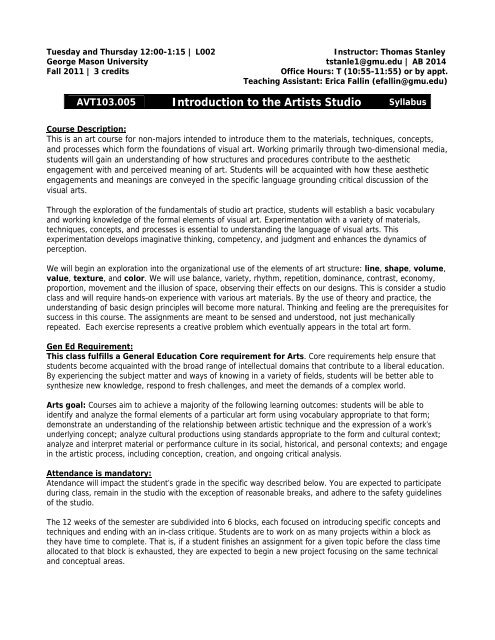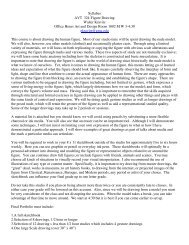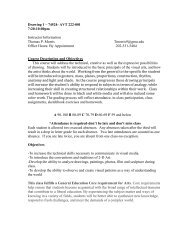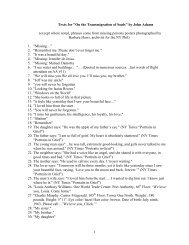103 Intro to Artist Studio Stanley.pdf - George Mason University
103 Intro to Artist Studio Stanley.pdf - George Mason University
103 Intro to Artist Studio Stanley.pdf - George Mason University
You also want an ePaper? Increase the reach of your titles
YUMPU automatically turns print PDFs into web optimized ePapers that Google loves.
Tuesday and Thursday 12:00-1:15 | L002<br />
Instruc<strong>to</strong>r: Thomas <strong>Stanley</strong><br />
<strong>George</strong> <strong>Mason</strong> <strong>University</strong> tstanle1@gmu.edu | AB 2014<br />
Fall 2011 | 3 credits<br />
Office Hours: T (10:55-11:55) or by appt.<br />
Teaching Assistant: Erica Fallin (efallin@gmu.edu)<br />
AVT<strong>103</strong>.005 <strong>Intro</strong>duction <strong>to</strong> the <strong>Artist</strong>s <strong>Studio</strong> Syllabus<br />
Course Description:<br />
This is an art course for non-majors intended <strong>to</strong> introduce them <strong>to</strong> the materials, techniques, concepts,<br />
and processes which form the foundations of visual art. Working primarily through two-dimensional media,<br />
students will gain an understanding of how structures and procedures contribute <strong>to</strong> the aesthetic<br />
engagement with and perceived meaning of art. Students will be acquainted with how these aesthetic<br />
engagements and meanings are conveyed in the specific language grounding critical discussion of the<br />
visual arts.<br />
Through the exploration of the fundamentals of studio art practice, students will establish a basic vocabulary<br />
and working knowledge of the formal elements of visual art. Experimentation with a variety of materials,<br />
techniques, concepts, and processes is essential <strong>to</strong> understanding the language of visual arts. This<br />
experimentation develops imaginative thinking, competency, and judgment and enhances the dynamics of<br />
perception.<br />
We will begin an exploration in<strong>to</strong> the organizational use of the elements of art structure: line, shape, volume,<br />
value, texture, and color. We will use balance, variety, rhythm, repetition, dominance, contrast, economy,<br />
proportion, movement and the illusion of space, observing their effects on our designs. This is consider a studio<br />
class and will require hands-on experience with various art materials. By the use of theory and practice, the<br />
understanding of basic design principles will become more natural. Thinking and feeling are the prerequisites for<br />
success in this course. The assignments are meant <strong>to</strong> be sensed and unders<strong>to</strong>od, not just mechanically<br />
repeated. Each exercise represents a creative problem which eventually appears in the <strong>to</strong>tal art form.<br />
Gen Ed Requirement:<br />
This class fulfills a General Education Core requirement for Arts. Core requirements help ensure that<br />
students become acquainted with the broad range of intellectual domains that contribute <strong>to</strong> a liberal education.<br />
By experiencing the subject matter and ways of knowing in a variety of fields, students will be better able <strong>to</strong><br />
synthesize new knowledge, respond <strong>to</strong> fresh challenges, and meet the demands of a complex world.<br />
Arts goal: Courses aim <strong>to</strong> achieve a majority of the following learning outcomes: students will be able <strong>to</strong><br />
identify and analyze the formal elements of a particular art form using vocabulary appropriate <strong>to</strong> that form;<br />
demonstrate an understanding of the relationship between artistic technique and the expression of a work’s<br />
underlying concept; analyze cultural productions using standards appropriate <strong>to</strong> the form and cultural context;<br />
analyze and interpret material or performance culture in its social, his<strong>to</strong>rical, and personal contexts; and engage<br />
in the artistic process, including conception, creation, and ongoing critical analysis.<br />
Attendance is manda<strong>to</strong>ry:<br />
Atendance will impact the student’s grade in the specific way described below. You are expected <strong>to</strong> participate<br />
during class, remain in the studio with the exception of reasonable breaks, and adhere <strong>to</strong> the safety guidelines<br />
of the studio.<br />
The 12 weeks of the semester are subdivided in<strong>to</strong> 6 blocks, each focused on introducing specific concepts and<br />
techniques and ending with an in-class critique. Students are <strong>to</strong> work on as many projects within a block as<br />
they have time <strong>to</strong> complete. That is, if a student finishes an assignment for a given <strong>to</strong>pic before the class time<br />
allocated <strong>to</strong> that block is exhausted, they are expected <strong>to</strong> begin a new project focusing on the same technical<br />
and conceptual areas.
date agenda assignment due<br />
8.30 course introduction/materials explained<br />
9.01 LINE<br />
9.06<br />
9.08 PROJECT 1<br />
9.13 SHAPE<br />
9.15<br />
9.20<br />
9.22 PROJECT 2<br />
9.27 VOLUME<br />
9.29<br />
10.04<br />
10.06<br />
10.11 NO CLASS<br />
10.13 PROJECT 3<br />
10.18 VALUE<br />
10.20<br />
10.25<br />
10.27<br />
11.01 PROJECT 4<br />
11.03 TEXTURE<br />
11.08<br />
11.10<br />
11.15<br />
11.17 PROJECT 5<br />
11.22 COLOR<br />
11.24 NO CLASS<br />
11.29<br />
12.01<br />
12.06<br />
12.08 PROJECT 6
Materials<br />
1) Old shirt or smock<br />
2) Box for pencils, pens, brushes and other small equipment<br />
3) Pencil sharpener<br />
4) Old newspaper<br />
5) 14 x 18 drawing pad<br />
6) graphite pencils 4B - 4H<br />
7) vine charcol sticks, soft and medium<br />
8) metal ruler w/cork back<br />
9) xac<strong>to</strong> knife and #11 blades<br />
10) rubber cement<br />
11) grid ruler<br />
12) Notebook (sketchbook)<br />
13) Portfolio <strong>to</strong> hold work (approx 17” x 22”)<br />
14) Liquitex acrylic paints (small set: ivory black, titanium, white, crimson red, cadmium<br />
yellow, phthalo blue or brilliant blue purple)<br />
15) 2 brushes, a #2 round and 6 flat (synthetic ½”)<br />
16) scissors & glue.<br />
17) 3 poster boards.<br />
Retail Art Outlets<br />
Plaza Art<br />
3045 Nutley St.<br />
Pan Am Shopping Center<br />
Fairfax (703) 280-4500<br />
Pearl Discount Centers<br />
5695 Telegraph Road<br />
Alexandria (703) 960-3900<br />
Utrecht Art Supply<br />
1250 Eye Street, NW<br />
Washing<strong>to</strong>n, DC<br />
(202) 898-0555<br />
<strong>University</strong> Books<strong>to</strong>re<br />
Johnson Learning Center<br />
GMU Campus<br />
(703) 993-2668<br />
Art S<strong>to</strong>re<br />
3019 M Street NW<br />
Washing<strong>to</strong>n, DC<br />
(202) 342-7030<br />
Blick<br />
http://www.dickblick.com/
<strong>University</strong> and AVT Department Policies<br />
In accordance with <strong>George</strong> <strong>Mason</strong> <strong>University</strong> policy, turn off all beepers, cellular telephones and other<br />
wireless communication devices at the start of class. The instruc<strong>to</strong>r of the class will keep his/her cell<br />
phone active <strong>to</strong> assure receipt of any <strong>Mason</strong> Alerts in a timely fashion; or in the event that the instruc<strong>to</strong>r<br />
does not have a cell phone, he/she will designate one student <strong>to</strong> keep a cell phone active <strong>to</strong> receive<br />
such alerts.<br />
Commitment <strong>to</strong> Diversity<br />
This class will be conducted as an intentionally inclusive community that celebrates diversity and welcomes the<br />
participation in the life of the university of faculty, staff and students who reflect the diversity of our plural society.<br />
All may feel free <strong>to</strong> speak and <strong>to</strong> be heard without fear that the content of the opinions they express will bias the<br />
evaluation of their academic performance or hinder their opportunities for participation in class activities. In turn,<br />
all are expected <strong>to</strong> be respectful of each other without regard <strong>to</strong> race, class, linguistic background, religion,<br />
political beliefs, gender identity, sex, sexual orientation, ethnicity, age, veteran’s status, or physical ability.<br />
Statement on Ethics in Teaching and Practicing Art and Design<br />
As professionals responsible for the education of undergraduate and graduate art and design students, the<br />
faculty of the School of Art adheres <strong>to</strong> the ethical standards and practices incorporated in the professional Code<br />
of Ethics of our national accreditation organization, The National Association of Schools of Art and Design<br />
(NASAD).<br />
Open <strong>Studio</strong> Hours<br />
SOA teaching studios are open <strong>to</strong> students for extended periods of time mornings, evenings and weekends<br />
whenever classes are not in progress. Policies, procedures and schedules for studio use are established by the<br />
SOA studio faculty and are posted in the studios.<br />
ArtsBus<br />
The dates for Fall 2011 ArtsBus trips are Sept 24, Oct 22, and Nov 19<br />
If you need ArtsBus credit for this semester, you must enroll in a section of AVT 300 (CRN # 71746,<br />
71747, 71748) before September 6 (after Sept 6 LATE FEE is added). This also applies <strong>to</strong> anyone who<br />
intends <strong>to</strong> travel <strong>to</strong> New York independently, or do the DC Alternate Assignment. If you plan/need <strong>to</strong> go on<br />
multiple ArtsBus trips this semester and need them <strong>to</strong>wards your <strong>to</strong>tal requirement, you must enroll in multiple<br />
sections of AVT 300. Please go <strong>to</strong> the ArtsBus website: http://artsbus.gmu.edu "Student Information" for<br />
additional, very important information regarding ArtsBus policy. Non-AVT majors do not need Artsbus credit<br />
BUT may need <strong>to</strong> go on the Artsbus for a class assignment. You can sign up for AVT 300 or buy a ticket for the<br />
bus at the Center of the Arts.<br />
Visual Voices Lecture Series<br />
Visual Voices is a year-long series of lectures by artists, art his<strong>to</strong>rians and others about contemporary art and<br />
art practice. Visual Voices lectures are held on Thursday evenings from 7:20- 9:00 p.m. in Harris Theater.<br />
September 8 Syllabus Presentation<br />
September 15 Henry Matthews, GVSU<br />
Developing a Vision<br />
September 29 Deborah Bright, RISD<br />
Destruction Layer: Palestine in Israel<br />
Oc<strong>to</strong>ber 13 Robert Gleason, His<strong>to</strong>ry Channel End of Days: Is It Closer Than You Think<br />
November 17 Wendy Ross, Sculp<strong>to</strong>r<br />
Vital Order: A Conversation with Wendy Ross<br />
Important Deadlines<br />
Last Day <strong>to</strong> Add (Full-Semester Course) September 6<br />
Last Day <strong>to</strong> Drop (Full-Semester Course) September 6<br />
Selective Withdrawal Period (Full-Semester Course) Oc<strong>to</strong>ber 3 – last day Oc<strong>to</strong>ber 28<br />
Incomplete work from Fall 2007 due <strong>to</strong> instruc<strong>to</strong>r Oc<strong>to</strong>ber 28
Once the add and drop deadlines have passed, instruc<strong>to</strong>rs do not have the authority <strong>to</strong> approve requests<br />
from students <strong>to</strong> add or drop/withdraw late. Requests for late adds (up until the last day of classes)<br />
must be made by the student in the SOA office (or the office of the department offering the course),<br />
and generally are only approved in the case of a documented university error (such as a problem with<br />
financial aid being processed) , LATE ADD fee will apply. Requests for non-selective withdrawals<br />
and retroactive adds (adds after the last day of classes) must be approved by the academic dean of the<br />
college in which the student’s major is located. For AVT majors, that is the CVPA Office of Academic<br />
Affairs, Performing Arts Building A407.<br />
Students with Disabilities and Learning Differences<br />
If you have a diagnosed disability or learning difference and you need academic accommodations, please<br />
inform me at the beginning of the semester and contact the Disabilities Resource Center (SUB I room 234, 703-<br />
993-2474). You must provide me with a faculty contact sheet from that office outlining the accommodations<br />
needed for your disability or learning difference. All academic accommodations must be arranged in advance<br />
through the DRC.<br />
Official Communications via GMU E-Mail<br />
<strong>Mason</strong> uses electronic mail <strong>to</strong> provide official information <strong>to</strong> students. Examples include communications from<br />
course instruc<strong>to</strong>rs, notices from the library, notices about academic standing, financial aid information, class<br />
materials, assignments, questions, and instruc<strong>to</strong>r feedback. Students are responsible for the content of<br />
university communication sent <strong>to</strong> their <strong>Mason</strong> e-mail account, and are required <strong>to</strong> activate that account and<br />
check it regularly.<br />
Attendance Policies<br />
Students are expected <strong>to</strong> attend the class periods of the courses for which they register. In-class<br />
participation is important not only <strong>to</strong> the individual student, but also <strong>to</strong> the class as a whole. Because<br />
class participation may be a fac<strong>to</strong>r in grading, instruc<strong>to</strong>rs may use absence, tardiness, or early departure<br />
as de fac<strong>to</strong> evidence of nonparticipation. Students who miss an exam with an acceptable excuse may<br />
be penalized according <strong>to</strong> the individual instruc<strong>to</strong>r's grading policy, as stated in the course syllabus.<br />
Honor Code<br />
Students in this class are bound by the Honor Code, as stated in the <strong>George</strong> <strong>Mason</strong> <strong>University</strong> Catalog. The<br />
honor code requires that the work you do as an individual be the product of your own individual synthesis or<br />
integration of ideas. (This does not prohibit collaborative work when it is approved by your instruc<strong>to</strong>r.) As a<br />
faculty member, I have an obligation <strong>to</strong> refer the names of students who may have violated the Honor Code <strong>to</strong><br />
the Student Honor Council, which treats such cases very seriously.<br />
No grade is important enough <strong>to</strong> justify cheating, for which there are serious consequences that will follow you<br />
for the rest of your life. If you feel unusual pressure about your grade in this or any other course, please talk <strong>to</strong><br />
me or <strong>to</strong> a member of the GMU Counseling Center staff.<br />
Using someone else’s words or ideas without giving them credit is plagiarism, a very serious Honor Code<br />
offense. It is very important <strong>to</strong> understand how <strong>to</strong> prevent committing plagiarism when using material from a<br />
source. If you wish <strong>to</strong> quote verbatim, you must use the exact words and punctuation just as the passage<br />
appears in the original and must use quotation marks and page numbers in your citation. If you want <strong>to</strong><br />
paraphrase or summarize ideas from a source, you must put the ideas in<strong>to</strong> your own words, and you must cite<br />
the source, using the APA or MLA format. (For assistance with documentation, I recommend Diana Hacker, A<br />
Writer’s Reference.) The exception <strong>to</strong> this rule is information termed general knowledge—information that is<br />
widely known and stated in a number of sources. Determining what is general knowledge can be complicated,<br />
so the wise course is, “When in doubt, cite.”<br />
Be especially careful when using the Internet for research. Not all Internet sources are equally reliable; some<br />
are just plain wrong. Also, since you can download text, it becomes very easy <strong>to</strong> inadvertently plagiarize. If you<br />
use an Internet source, you must cite the exact URL in your paper and include with it the last date that you<br />
successfully accessed the site.






